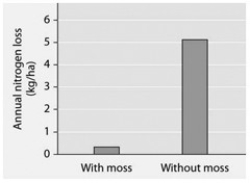Researchers tested nitrogen loss from soil where the moss Dawsonia was growing and compared it to soil from which Dawsonia had been removed. The data are presented in the accompanying figure. 
-If the actual results most closely resembled those in part (A) in the figure above, then a further question arising from these data is: "Do the Dawsonia rhizoids have to be alive to reduce soil nitrogen loss, or do dead rhizoids have the same effect?" Arrange the following steps in the correct sequence to test this hypothesis.
1) Add metabolic poison to the soil of the experimental plot of mosses.
2) Apply water equally to the experimental and control plots.
3) Measure initial soil nitrogen contents of control and experimental plots.
4) Determine nitrogen loss from the soil of control and experimental plots.
5) Establish two identical plots of Dawsonia mosses; one as a control, the other as the experimental treatment.
Definitions:
Right Temporal Lobe
The portion of the brain located beneath the right temple, responsible for processing auditory information and contributing to the understanding of language and the integration of memories.
Left Parietal Lobe
A region of the brain associated with processing sensory information such as touch, temperature, and pain, as well as spatial orientation and language.
Handedness
The preferential use of one hand over the other for performing tasks; commonly categorized into right-handedness, left-handedness, ambidexterity, and mixed-handedness.
Language
Language is a system of communication that uses symbols, sounds, or gestures to convey meaning, enabling humans to express ideas, thoughts, and emotions.
Q12: A major function of magnesium in plants
Q14: Two researchers experimentally formed tetraploid frogs by
Q18: You find a multilegged animal in your
Q21: What is a primary difference between polymerase
Q22: To reproduce, many plants produce seeds-structures containing
Q25: Among protostomes, which morphological trait has shown
Q30: A virus consisting of a single strand
Q39: Which of the following is consistent with
Q49: The bonding of two amino acid molecules
Q55: If cells are grown in a medium